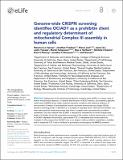| dc.contributor.author | Le Vasseur, Maxence | |
| dc.contributor.author | Friedman, Jonathan | |
| dc.contributor.author | Jost, Marco | |
| dc.contributor.author | Xu, Jiawei | |
| dc.contributor.author | Yamada, Justin | |
| dc.contributor.author | Kampmann, Martin | |
| dc.contributor.author | Horlbeck, Max A | |
| dc.contributor.author | Salemi, Michelle R | |
| dc.contributor.author | Phinney, Brett S | |
| dc.contributor.author | Weissman, Jonathan S | |
| dc.contributor.author | Nunnari, Jodi | |
| dc.date.accessioned | 2021-10-27T20:24:17Z | |
| dc.date.available | 2021-10-27T20:24:17Z | |
| dc.date.issued | 2021 | |
| dc.identifier.uri | https://hdl.handle.net/1721.1/135619 | |
| dc.description.abstract | <jats:p>Dysfunction of the mitochondrial electron transport chain (mETC) is a major cause of human mitochondrial diseases. To identify determinants of mETC function, we screened a genome-wide human CRISPRi library under oxidative metabolic conditions with selective inhibition of mitochondrial Complex III and identified ovarian carcinoma immunoreactive antigen (OCIA) domain-containing protein 1 (OCIAD1) as a Complex III assembly factor. We find that OCIAD1 is an inner mitochondrial membrane protein that forms a complex with supramolecular prohibitin assemblies. Our data indicate that OCIAD1 is required for maintenance of normal steady-state levels of Complex III and the proteolytic processing of the catalytic subunit cytochrome <jats:italic>c<jats:sub>1</jats:sub></jats:italic> (CYC1). In OCIAD1 depleted mitochondria, unprocessed CYC1 is hemylated and incorporated into Complex III. We propose that OCIAD1 acts as an adaptor within prohibitin assemblies to stabilize and/or chaperone CYC1 and to facilitate its proteolytic processing by the IMMP2L protease.</jats:p> | |
| dc.language.iso | en | |
| dc.publisher | eLife Sciences Publications, Ltd | |
| dc.relation.isversionof | 10.7554/elife.67624 | |
| dc.rights | Creative Commons Attribution 4.0 International license | |
| dc.rights.uri | https://creativecommons.org/licenses/by/4.0/ | |
| dc.source | eLife | |
| dc.title | Genome-wide CRISPRi screening identifies OCIAD1 as a prohibitin client and regulatory determinant of mitochondrial Complex III assembly in human cells | |
| dc.type | Article | |
| dc.contributor.department | Massachusetts Institute of Technology. Department of Biology | |
| dc.contributor.department | Whitehead Institute for Biomedical Research | |
| dc.relation.journal | eLife | |
| dc.eprint.version | Final published version | |
| dc.type.uri | http://purl.org/eprint/type/JournalArticle | |
| eprint.status | http://purl.org/eprint/status/PeerReviewed | |
| dc.date.updated | 2021-08-03T18:58:44Z | |
| dspace.orderedauthors | Le Vasseur, M; Friedman, J; Jost, M; Xu, J; Yamada, J; Kampmann, M; Horlbeck, MA; Salemi, MR; Phinney, BS; Weissman, JS; Nunnari, J | |
| dspace.date.submission | 2021-08-03T18:58:46Z | |
| mit.journal.volume | 10 | |
| mit.license | PUBLISHER_CC | |
| mit.metadata.status | Authority Work and Publication Information Needed | |
